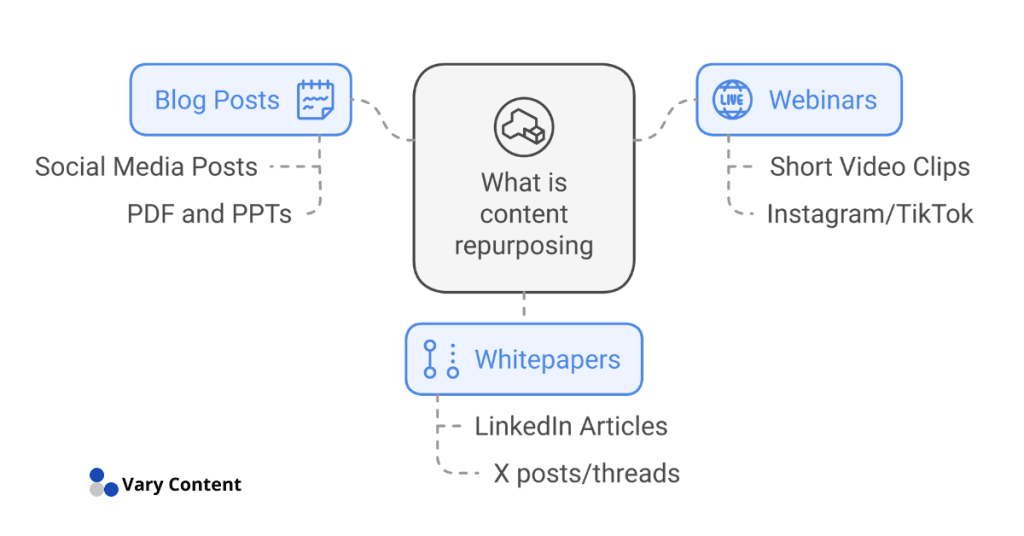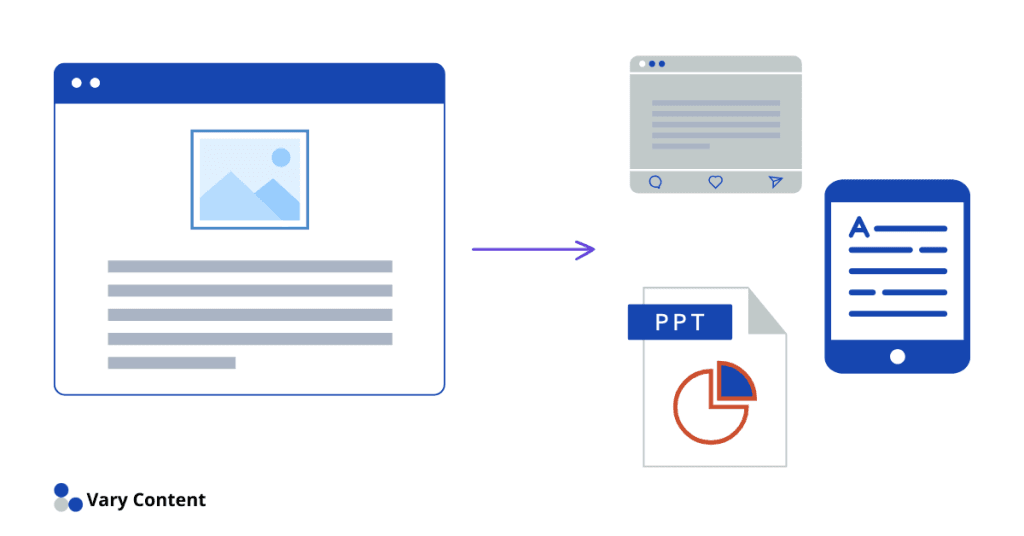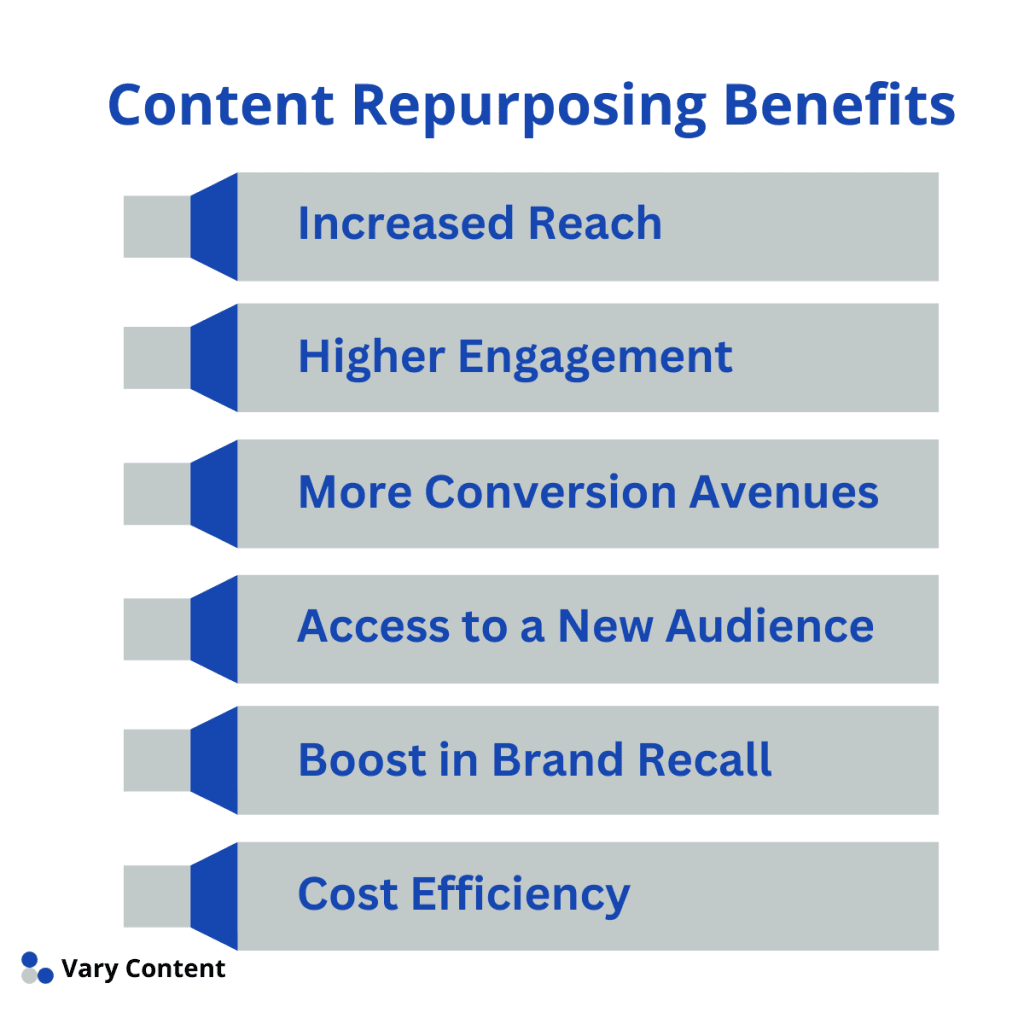Creating high-quality content takes time, effort, and resources—so why settle for letting it disappear into the depths of your archives after just one use?
This is where content repurposing comes in. It’s the secret ingredient that allows marketers, content creators, and business owners to squeeze every bit of value out of their hard work by giving new life to existing content.
What is Content Repurposing?

Content repurposing involves taking existing content, such as a blog post, video, or webinar, and adapting it into a new format or channel to reach a broader audience. Unlike simply resharing content, repurposing means re-working or modifying content to make it valuable and suitable for a specific platform or audience.
For example:
- A blog post can become a social media carousel or infographic.
- A webinar can be broken down into short video clips for Instagram or TikTok.
- A long-form whitepaper can be divided into multiple short LinkedIn articles.
Content Repurposing Examples

Here are examples of content repurposing to help you get ideas:
1. HubSpot
HubSpot’s long-form guides often become webinar topics, YouTube tutorials, and even Instagram graphics.
2. TED Talks
Did you know that TED repurposes its talks into podcasts, short social video clips, blogs, and even books? Each format targets a specific type of consumer.
3. Buzzfeed
From quizzes to listicles and Instagram stories, Buzzfeed knows how to adapt its content to fit different platforms seamlessly.
Benefits of Repurposing Content

Here’s why content repurposing is an essential strategy:
1. Increased Reach
Not every potential audience member hangs out in the same place. With content repurposing, you can meet them where they prefer to be.
- For instance, turn a podcast episode into a blog post for readers who prefer written content.
- Share excerpts from your blogs as tweets to engage with short-form content audiences.
2. Access to a New Audience
Different formats naturally appeal to different groups. A video may resonate with visual learners, while an infographic might grab the attention of more data-driven individuals.
Giving your content multiple forms ensures you connect with diverse consumer preferences, bringing new people into your ecosystem.
3. More Conversion Avenues
With repurposed content distributed across multiple platforms, you naturally expand your entry points for conversions. For example:
- A snippet of a YouTube interview could spark curiosity and drive viewers to your full webinar sign-up page.
- An infographic on Pinterest could link to a blog where readers download a free guide.
4. Higher Engagement
Audiences are far more likely to engage with content tailored specifically for their platform or format of choice. For example:
- Moz’s Whiteboard Friday videos demonstrate how content optimized for visuals can drive steady engagement on a weekly basis. Their lessons are then converted into follow-up blog posts for those who prefer written breakdowns.
5. Boost in Brand Recall
Repurposing content creates multiple touchpoints for your audience, which increases brand visibility and recall. Seeing consistent expert advice across platforms solidifies trust in your expertise and authority.
6. Cost Efficiency
Creating new content from scratch requires significant energy and budget. Repurposing takes far less time and provides a much higher return on your original investment. A single piece of foundational content can evolve into multiple high-performing spin-offs.
Best Practices for Repurposing Content
To make the most out of content repurposing, follow these strategies:
1. Use Evergreen Content
Focus on content with long-term value—think timeless how-to guides or foundational knowledge pieces. This ensures that your repurposed content remains relevant for years to come.
Evergreen content refers to material that remains valuable and relevant long after it’s published. Unlike time-sensitive pieces such as news articles or event promotions, evergreen content addresses topics with lasting appeal. This can include tutorials, FAQs, case studies, or listicles that answer common questions or provide solutions that are unlikely to change over time.
Evergreen content works best for repurposing because it can be reworked to fit various formats and platforms without losing its value. You can update evergreen content periodically, but the core information remains unchanged.
2. Repurpose High-Performing Content
Determine which pieces of content are performing well and could potentially be repurposed into other formats. Look for topics with high engagement or traffic, and consider how they can be adapted into a different medium.
Google Analytics is the best source to find high performing content . It allows you to see which pages on your website are getting the most traffic and engagement, as well as what keywords are bringing people to those pages.
Additionally, social media analytics can also provide insights into your most popular posts and topics. This data can help guide your repurposing strategy by showing you what content resonates with your audience.
3. Consider Your Audience
When repurposing content, consider your target audience and the platform you’re using. What format is best suited for them? How do they consume content on this platform?
For example, if your audience is primarily visual learners, repurposing a written blog post into an infographic or video may be more effective than simply reposting the text on social media.
Additionally, different platforms have different features and limitations that should be taken into consideration when repurposing content. For instance, Twitter has a character limit, so repurposing a lengthy blog post into smaller tweets would be more suitable.
4. Collaborate With Your Audience
Your audience can be a goldmine for repurposing ideas. Pay attention to comments, questions, and feedback they leave on your content. These insights can help guide you in creating new formats that directly address their needs or interests. For instance, a frequently asked question in the comments section of a blog post could inspire a quick how-to video or a social media carousel. Collaboration builds loyalty and generates fresh content ideas.
5. Incorporate Seasonal and Trending Topics
Aligning your repurposed content with seasonal events, holidays, or trending themes can give it a boost in relevance and engagement. For example, an evergreen blog post about productivity could be updated and shared with a “New Year, New You” framework. Staying timely not only attracts more attention but also shows that your brand is responsive and in tune with current events.
6. Create Long-Form Resources
Breathe new life into your highest-performing pieces by compiling them into guides, eBooks, or whitepapers. Long-form resources provide immense value to audiences who want a deep dive into your expertise. This not only creates a new asset but also positions your brand as an authority in the industry.
7. Repurpose Across Multiple Channels
Don’t limit yourself to just one platform when repurposing content. Different channels have different audiences and preferences, so it’s important to tailor your content for each one. For example, a blog post can be turned into a podcast episode, infographic, or webinar. This allows you to reach a wider audience and maximize the impact of your content.
8. Measure and Analyze Results
As with any marketing strategy, it’s crucial to measure and analyze the results of your content repurposing efforts. Look at metrics such as engagement rates, website traffic, and lead generation to determine the success of each repurposed piece. This can help you refine your strategy and make informed decisions for future content repurposing.
9. Don’t Forget About SEO
When repurposing content, it’s important to keep search engine optimization (SEO) in mind. Make sure to include relevant keywords and meta descriptions in your new pieces to improve their visibility in search engine results. This will help drive organic traffic to your website and increase overall brand awareness.
Maximize Output From Existing Content Starting Today
Content repurposing is a game-changer for marketers, creators, and businesses alike. By maximizing the value of your hard work, you reach new audiences, drive higher engagement, and significantly boost your ROI. Whether you start small—like turning a blog post into an infographic—or aim big by producing a complete content ecosystem, the opportunities are endless.
Remember, the key to staying competitive in today’s digital landscape isn’t just creating more content—it’s maximizing the value of what you’ve already made.
